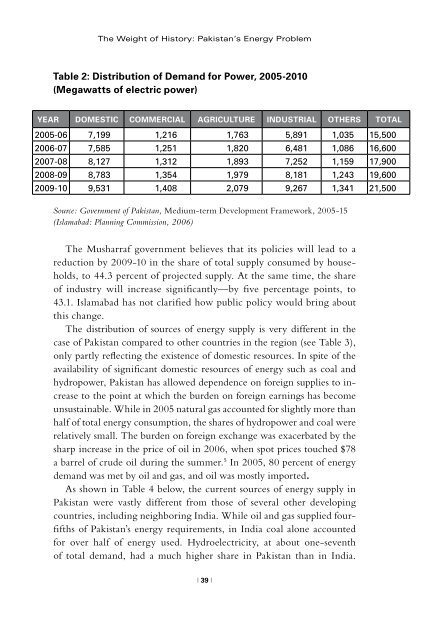fueling the future - Woodrow Wilson International Center for Scholars
fueling the future - Woodrow Wilson International Center for Scholars
fueling the future - Woodrow Wilson International Center for Scholars
- No tags were found...
Create successful ePaper yourself
Turn your PDF publications into a flip-book with our unique Google optimized e-Paper software.
The Weight of History: Pakistan’s Energy ProblemTable 2: Distribution of Demand <strong>for</strong> Power, 2005-2010(Megawatts of electric power)Year domestic Commercial Agriculture Industrial O<strong>the</strong>rs total2005-06 7,199 1,216 1,763 5,891 1,035 15,5002006-07 7,585 1,251 1,820 6,481 1,086 16,6002007-08 8,127 1,312 1,893 7,252 1,159 17,9002008-09 8,783 1,354 1,979 8,181 1,243 19,6002009-10 9,531 1,408 2,079 9,267 1,341 21,500Source: Government of Pakistan, Medium-term Development Framework, 2005-15(Islamabad: Planning Commission, 2006)The Musharraf government believes that its policies will lead to areduction by 2009-10 in <strong>the</strong> share of total supply consumed by households,to 44.3 percent of projected supply. At <strong>the</strong> same time, <strong>the</strong> shareof industry will increase significantly—by five percentage points, to43.1. Islamabad has not clarified how public policy would bring aboutthis change.The distribution of sources of energy supply is very different in <strong>the</strong>case of Pakistan compared to o<strong>the</strong>r countries in <strong>the</strong> region (see Table 3),only partly reflecting <strong>the</strong> existence of domestic resources. In spite of <strong>the</strong>availability of significant domestic resources of energy such as coal andhydropower, Pakistan has allowed dependence on <strong>for</strong>eign supplies to increaseto <strong>the</strong> point at which <strong>the</strong> burden on <strong>for</strong>eign earnings has becomeunsustainable. While in 2005 natural gas accounted <strong>for</strong> slightly more thanhalf of total energy consumption, <strong>the</strong> shares of hydropower and coal wererelatively small. The burden on <strong>for</strong>eign exchange was exacerbated by <strong>the</strong>sharp increase in <strong>the</strong> price of oil in 2006, when spot prices touched $78a barrel of crude oil during <strong>the</strong> summer. 5 In 2005, 80 percent of energydemand was met by oil and gas, and oil was mostly imported.As shown in Table 4 below, <strong>the</strong> current sources of energy supply inPakistan were vastly different from those of several o<strong>the</strong>r developingcountries, including neighboring India. While oil and gas supplied fourfifthsof Pakistan’s energy requirements, in India coal alone accounted<strong>for</strong> over half of energy used. Hydroelectricity, at about one-seventhof total demand, had a much higher share in Pakistan than in India.| 39 |
















